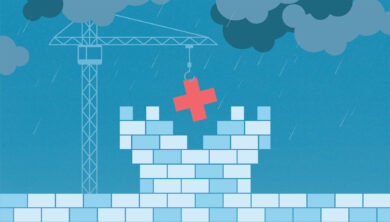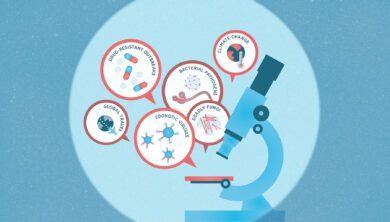
How One Indigenous Service Agency Is Fighting COVID and Winning
Series | Public Service Innovation and Leadership During COVID-19In March of 2020 as the world was starting to learn about COVID-19, First Nations communities across the country were on high alert. The historical outcomes from past pandemics and epidemics did not bode well for many Indigenous nations.
Chief Lorraine Cobiness of Niisaachewan Anishinaabe Nation, northwest of Kenora in the Treaty Three area of Ontario, was not about to let this virus ravage her community. She was doing all she could to keep it out, facing a daunting task, but not alone.
Cobiness says help from the Kenora Chiefs Advisory (KCA) came swiftly, and the Indigenous-led service agency was with her community every step of the way. “[They were] never once afraid of coming into our communities and saying, how can we help you? What can we do? What do you need? They were at the top of the list who came in and said, we’re going to help you. We’re going to help deliver food. We’re going to help deliver medicine. We’re going to send our helpers in and we’re not going to stop, and they never did right from day one.”
KCA provides culturally appropriate health and social services to the nine First Nations it serves. Communities that fall within the Treaty 3 area are small, between 300 and 1,500 people. Most communities have only one store or none at all. Chronic underfunding has resulted in a housing shortage, leaving multiple generations sharing small, overcrowded homes. Some have a federal nursing station, often understaffed; none have resident doctors and other resources afforded larger centres. Despite these challenges, from the onset of the pandemic until time of print, there were only two cases of COVID-19 identified in these First Nations. The cases were addressed immediately with no further spread.
The KCA strives to empower and support each of the communities it serves. The Executive Director is Joe Barnes, a successful businessman, educated in social work, and at one time in his life homeless and living on the streets. His personal experience is what drew him into wanting to help others. When he took the position as the head of the organization a decade ago, there were only 12 staff members. Today it employs nearly 140 people.
From the moment Barnes started at KCA, he looked at doing things differently, starting by listening to communities. “We don’t work within a box. We’ve never put ourselves within a box. And you know what I mean by that, like governments come out with this is how you have to do things, this is where you need to do it. We’ve been able to get rid of that box. And thanks to the Chiefs and the leadership of the Chiefs, they wanted that because sometimes those restrictions restrict you from being able to provide the services when and where people need it the most.”
The majority of the work they do is to empower and support each of their communities to build their own capacity, be it training or administrative support. They also provide prevention care in mental health and primary care to address any health issues before they become medical emergencies.
Barnes says the Kenora area has some of the highest numbers of residential school survivors in this area and also, some of the highest rates of suicide. The legacy of residential schools and colonial oppression means the burden of underlying health conditions that can lead to COVID fatalities is high. “We’re constantly dealing with emergencies. And we’ve been able to address that by coming together.”
The work they do is largely crisis-based. Experience has taught them hard lessons in how to respond to emergency situations, and to remain calm when these situations come up. Necessity has taught them to find solutions to problems and gaps in services. When COVID struck, that experience was key, preparing the agency to respond to immediate needs while keeping communities safe.
One of the first things KCA did when COVID-19 hit was take inventory of their community members’ health. The people with secondary health issues were put in a higher class, meaning they needed to be protected at all costs.
“The Chiefs are saying what they thought they needed, we just did it. We allocated staff and resources and just made it happen. You don’t have time to not make it happen. If you take too much time planning, too many people could have gotten sick,” explains Barnes.
In order to respond to community needs quickly, communication was crucial, both within the communities, and within the organization. Billy Boucher is the Director of Adult and Mental Health Services for KCA. He says in the beginning of the pandemic there was an open line of communication with all levels of the organization, from people on the ground level to each chief in the communities they serve. That was made possible by internet connectivity and the app Zoom. “We also had a teleconference line secured. There were daily debriefings with the leadership of our communities. I think we were having meetings pretty much every couple of days, debriefings almost on a daily basis. We’re having general staff meetings once a week, just to kind of give our staff an update as to how everybody was doing and allowing our staff to provide that feedback.”
The first thing everyone talked about was the safety of their communities, applying what was being said from the World Health Organization: stay home and social distance. The KCA began to consider how that would look in the community. They dusted off whatever pandemic plans they had in place, updating them to meet the current need and addressing the safety concerns that were arising from within each community.
Travel restrictions were put in place and it was very important to relay as much current information as possible about why. Community members were instructed to reschedule appointments in larger urban centres, for the best interest of their families.
Cobiness says they have never let their guard down in Niisaachewan and still have security checkpoints operating 24/7. “We have never let up on our documentation either,” she says.
When the security checkpoints were first erected, the frontline staff started doing their own data collection to be proactive in contract tracing. “Being able to track our own data, ask our own questions, monitor who’s coming in and out of our community. Nobody gets in or out without our knowledge unless they’re trying to creep in through the river,” says Cobiness.
Daphne Armstrong, the director of Strategy and Innovation Technology Policy with KCA, says they always followed the lead on what direction the community was taking. “One thing that was pretty consistent was the decision to have checkpoints and really be monitoring the ins and outs of communities. And that was a different response in each community in the sense that, some had complete non-residents restrictions, some you had to get pre-approval from the Chief and Council.”
Food security was another problem that needed to be addressed, especially as entry in and out of the communities became more restrictive. KCA helped to keep food stocks up by accessing larger, wholesales to buy in bulk.
“And it was very, very on the spot, very, very fluid,” Boucher said, explaining that a request was made for federal funds to cover the urgent need of food security. “Within days of that phone conversation or email, there were dollars that were being made available just for that.” Funding from Indigenous Services Canada (ISC) and the First Nations and Inuit Health Branch (FNIHB) came swiftly, without delay.
While most reserve funding comes from federal dollars, Boucher said in cases where funding ISC isn’t offered quickly enough, KCA will pick up the tab for something deemed a necessity, drawing on the agency’s charitable branch.
By prioritizing people’s basic needs, such as food, cleaning supplies, water, and devices to stay connected, it removed the stress of having to travel into the bigger city shopping centres.
Cobiness attributes open communication, good strategies, and working together as fundamental to success. “It’s having that courage to be blunt, to bring those issues to the forefront and being very communicative in terms of saying this is what I need, this is what my people need. And it’s not one prescription is going to fix all,” explains Cobiness. Each nation is unique in their needs and their resources.
Most communities KCA serves have road access, but two can be reached only by air or winter road. For the two communities that were accessible by road only in the winter, KCA purchased an air boat to bring supplies in once the ice road was no longer viable, following community direction and need.
What Armstrong found most interesting at a community level was how this virus got everyone to slow down and reevaluate all their relationships and how they cared for one another. She saw that people went back to what they inherently knew—gathering medicine, gathering traditional food—all knowledge they had from the land, and she helped them with the rest. Community leaders and chiefs encouraged community members to go out on the land to access traditional foods. “We were able to support a lot of food security.” By not needing to worry about meeting their basic food needs, community members were able to remain at home and avoid shopping in busy markets.
Of course, COVID-19 also presented urgent healthcare challenges. The pandemic has highlighted the longstanding lack of healthcare resources in First Nations, many of which have no full-time resident doctors or nurses, and depend on under-funded and under-staffed federal nursing stations.
One of the ways KCA responded was to work with the local physicians and bring them into the communities. Some of the physicians had never been in a First Nations community before but if they were invited in, they went. Barnes says he got nine doctors to deliver primary care where it was needed without making the residents have to travel long distances to seek care. “And that primary care that’s going into the communities right now, we want to try to maintain even after COVID, because it’s something that’s been much needed for years.”
Public education about health protocols was also crucial. KCA workers were on site in communities to offer advice on infection control best practices, safe food handling, and how to judge six feet distancing. They made themselves available to any questions that arose. They helped in retrofitting their mobile testing unit by installing plexiglass and other safeguards. “We have two environmental health officers that were able to support us in making sure we’re doing things safely, as well as doing a lot of teaching in the community around infection control and helping support some of those community plans on what their response strategies are going to be,” says Armstrong.
Another stressor KCA tried to mitigate was people’s mental health and addictions issues in the communities they serve. The agency offers programming as much as they can in communities, with the aid of environmental health officers. As much as possible, this programming was adapted to continue while complying with COVID safety protocols.
Crisis managers took a look at clients that were at high risk or would need additional support and provided wellness checks. Some health checks were done over the phone or with the aid of the internet, but always as visible in the community as possible.
When in-person health care wasn’t safe, virtual care was the other solution. But virtual care in a remote First Nation isn’t always possible. Efforts were complicated by factors like poor infrastructure, and overcrowded housing, Armstrong says.
“Do you have a home where you have a private place to talk? Do you have a phone in your home? Do you have a reliable internet connection in your home? These were all barriers that completely impede doing good virtual care,” says Armstrong. If virtual care was an option but
the person needing care lacked a device, KCA simply purchased a phone, a tablet, a laptop to connect the community with a healthcare crisis worker.
By prioritizing communication, listening to community needs, and reacting quickly, the agency was able to help address many of the urgent needs of communities during the pandemic. However, COVID has highlighted the inequities that many First Nations face—and the need for more substantial change. Lack of clean drinking water, adequate housing, lack of primary care are among the barriers that are putting communities at higher risk. These are the barriers that KCA, All Nations Health Partners and the nine chiefs that sit on the board of directors of KCA are trying to break down.
“It [COVID] has challenged us to look at all the systemic changes that we need to make. It’s time to start pulling our heads out of our butts and start working together. In saying that, it does not mean that we sit back and get dictated to as Anishinaabe people. It means that we do our best to educate others about our inherent rights, our inherent laws that supersede any kind of constitutional treaty that is given to us by a colonial system,” says Cobiness.
After one family member in one of the nine communities contracted COVID-19, while living in an over-crowded house that was under a boil water advisory, all parties adapted and responded immediately. “We moved the family to another community where we had a healing lodge that we shut down because of COVID and we put them in there. But we should already have the infrastructure in our communities, our First Nations communities. We should have clean water for people. So policy changes, policy needs to change within the government to ensure that our communities, our First Nation communities aren’t at such high risk,” says Barnes.
Cobiness gets emotional when she talks about her vision for moving forward; the two worlds of traditional knowledge of land and medicine married with mainstream best practices and medicine. Yet many First Nations do not even have a doctor in their community and rely solely on the work Elders are doing to keep their communities safe. It’s a lot to be asked of the most regarded and yet vulnerable population.
“We had to think outside the box, we need to keep our people safe, which means we need to provide more primary care. So we had actually developed a plan under the Kenora Chiefs Advisory and brought in seven doctors to nine of our communities,“ she says. The Elders from our communities have gone out on the land and put out their offerings while also following the advice of world health professions. “We have gone out and done all these other things and adhered to looking at integrating both perspectives.”
Like Cobiness, Barnes trusts in the power of culture, traditions and performing ceremonies to keep communities safe. “I think the Elder leadership did a lot for us in a ceremony. Our organisation is built on ceremony and traditions and they protected us. They guided us. Even though they couldn’t get together, they still had ceremonies to give us strength.”
Cobiness says this virus is a teacher with a lot of knowledge to offer. It is teaching us the importance of respecting our relationships, not only in how we relate to one another but also with the land and animals. The partnerships, from grassroots levels to regional and federal, grew from a working relationship to one with respect aimed at obtaining equality. With respect comes equality. The virus has also emphasized the importance of health agencies listening to what communities say they need. “We will let you know what we need in moving forward, in coming up with these solutions and being equal decision makers.”
KCA is also looking forward to how it can continue to support communities as the pandemic draws on. The agency has just purchased 374 acres of land with a mile and a half of waterfront in Kenora. They purchased it for their youth wellness camp so the youth could get back to the land and use traditional knowledge, from tanning hides, to crafting moccasins, to learning the language. With the second wave of COVID-19 looming overhead, this land will give everyone enough space to spread out and be safe while reducing mental health stress.
“We’re still thinking forward like that and planning forward,” says Barnes.
The Government of Canada, The Wilson Foundation, The Lawson Foundation and Microsoft.








